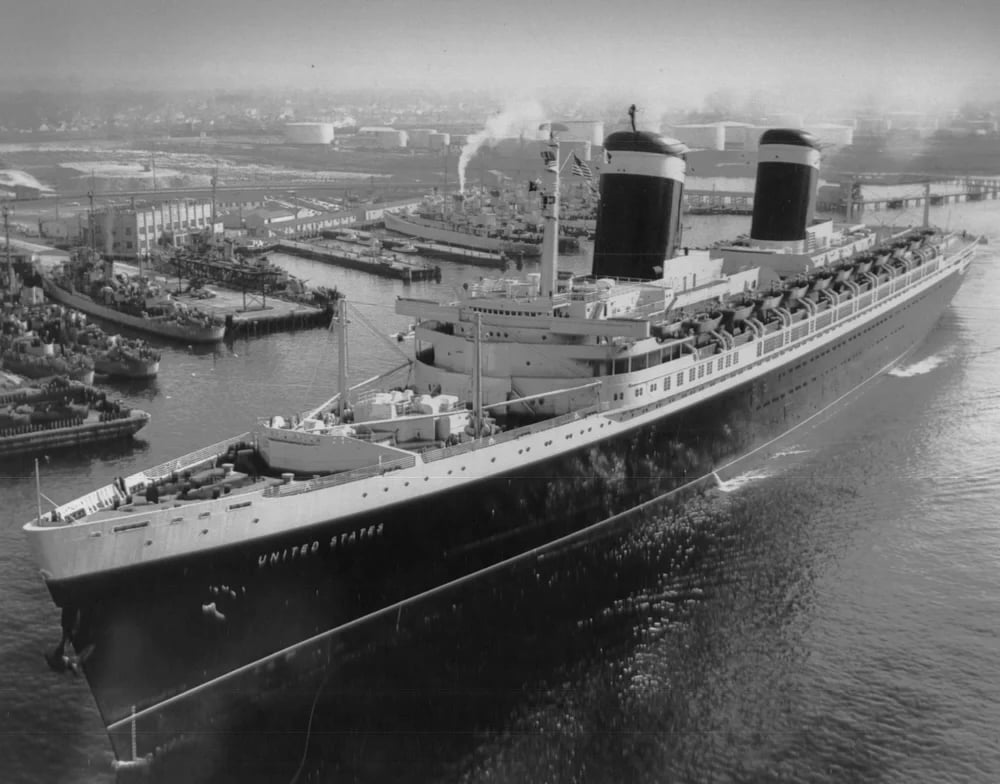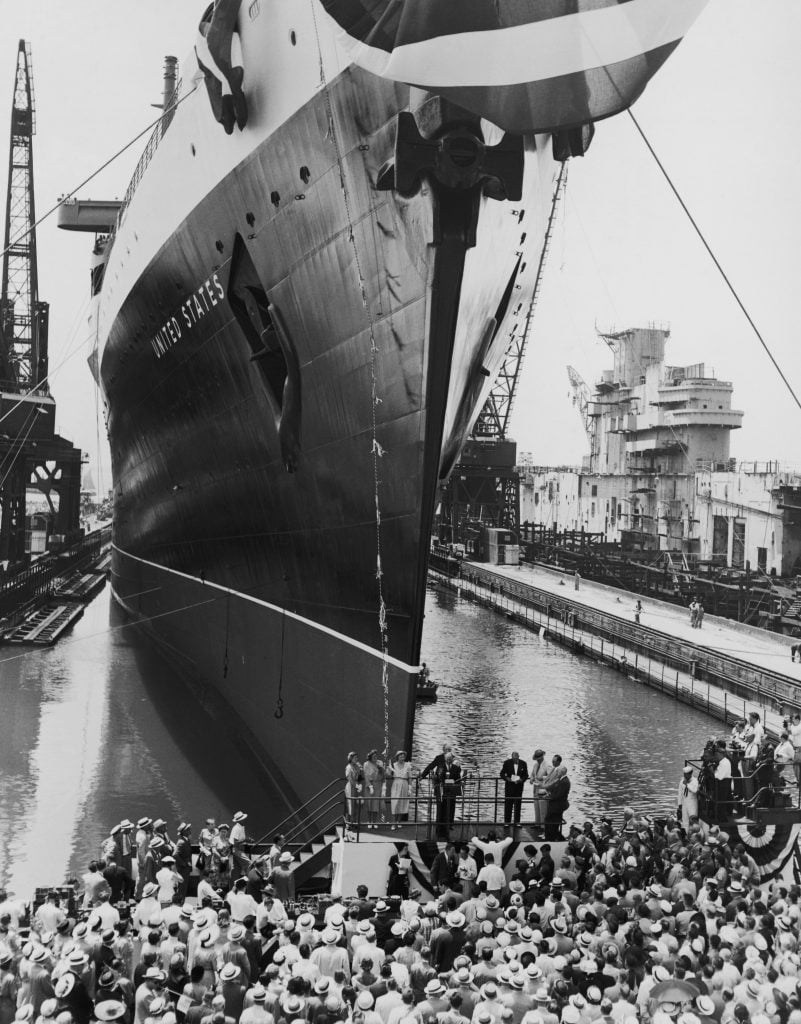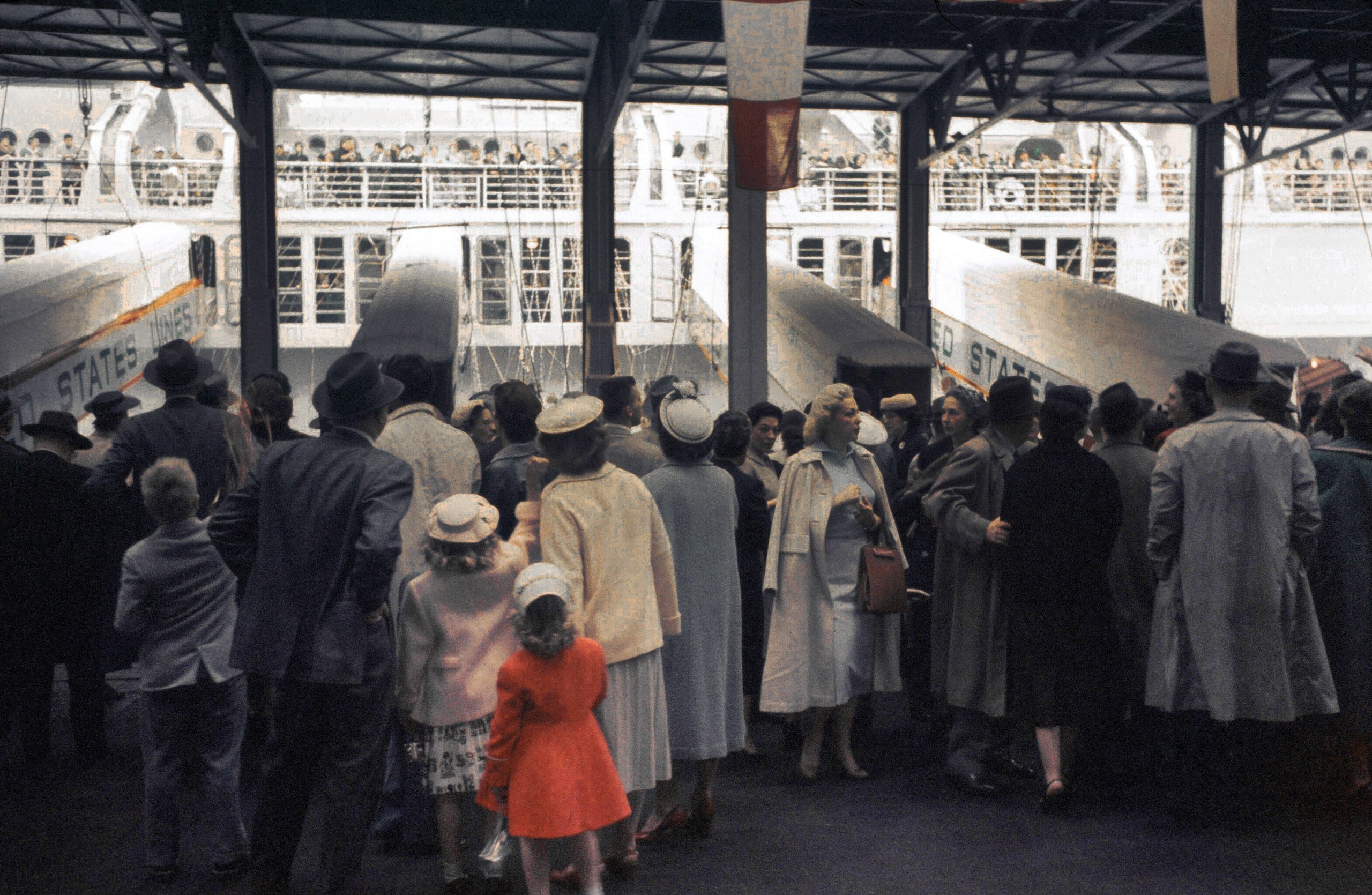The SS United States, an ocean liner so famous and historically significant that her advocates liken her to the Liberty Bell, the Washington Monument, and the Statue of Liberty, was set to be evicted from her longtime home in Philadelphia yesterday. But an eleventh-hour legal filing has extended the battle over the ship’s fate.
The ship’s owner, the SS United States Conservancy, had spent the last 90 days trying to find a new home for the vessel, in accordance with a June ruling from Judge Anita Brody. But while the September 12 deadline to move has come and gone, the dispute is still unresolved.
The lawsuit represents the hard times that the vessel known as “America’s Flagship” has fallen upon. The United States is the fastest passenger ship ever built, and the largest ever made in her namesake country.
Her many famous passengers include not only celebrities and heads of state, but also art world notables such as Salvador Dalí, who is said to have sailed with his pet ocelot. And when the Mona Lisa made her one and only journey to the U.S. in 1963, it was the United States that got her safely back to France.
William Francis Gibbs designed the luxury ocean liner, built in 1951 and ’52. It could convert into a troop carrier for 14,000 service members, and still holds the record for the fastest transatlantic crossing, set during her maiden crossing in 1952. But the United States has been out of service since 1969. Her interiors were stripped and auctioned in 1984, and she is not open to the public due to Homeland Security regulations—as well as the deteriorated state of the vessel.
The United States has been at Philadelphia’s Pier 82 since 1996, but a legal battle began in 2021, when the landlord, Penn Warehousing, tried to double the daily rent that had been in place since 2011 to $1,700. (The conservancy bought the ship for $3 million in 2011.)
The judge found Penn Warehousing couldn’t collect the increased rent that had sparked the dispute, but it did have the right to terminate the ship’s lease, which it did in March 2022. (By that point, the rent hike had accumulated to $290,700.)
The conservancy had long hoped to restore the ship, turning it into a mixed use project that would be part museum and part hotel, with restaurants and other attractions. But various development efforts over the years—most recently from real estate firm RXR and MCR Hotels at New York’s Pier 76—have failed.
A rendering of the SS United States at New York’s Pier 76, converted into a hotel and entertainment complex. Image courtesy of RXR and MCR Hotels.
At nearly 1,000 feet long—that’s longer the Titanic—the United States can’t dock just anywhere. And she isn’t fit to moor at sea. So as the deadline for eviction loomed, the only option seemingly left to save the ship from being scrapped was to sink her, creating an artificial reef.
The new legal filing maintains that Penn Warehousing’s “bad faith is preventing the conservancy from removing the ship” and that the landlord is preventing the sale of the United States to Okaloosa County, Florida, for $1 million.
The plan was to create the world’s largest artificial reef—Okaloosa is already home to the “Great Carrier Reef,” the USS Oriskany, sunk in 2006 and currently the world’s largest reefed vessel. The county would also build an accompanying “land-based legacy museum” honoring the history of the United States, even as it stripped her of the title of the “most famous ship that didn’t sink.”
“Reefing, while not our preferred outcome, presents several advantages over scrapping the vessel,” the conservancy wrote in a recent email to supporters. “Deploying the ship as an artificial reef activates her economic and tourism potential, enhances marine habitat and ecosystems, and provides the conservancy with the opportunity to create a multi-dimensional visitor experience that educates the public about America’s Flagship and her legacy, incorporates iconic components from the ship, and offers public access to our archival and curatorial collections.”
The conservancy states that Penn Warehousing agreed in court that the ship could remain docked past the September 12 deadline, until December after hurricane season, as long as there was a contract for its sale and removal. But when Okaloosa County met with the company to make the arrangements to move the United States, Penn Warehousing allegedly demanded a $3 million “ransom.” The conservancy said the company had previously offered the ship for sale to the county for $2.5 million—even though it doesn’t own the vessel.
“After decades of paying our pier rent in full and on time, pier operator Penn Warehousing has brought us to the brink of losing the SS United States, an inspiring expression of her namesake nation’s strength, unity, and pride,” conservancy president Susan Gibbs, granddaughter of the ship’s designer, William Francis Gibbs, said in a statement. “Last month, the SS United States Conservancy committed in court to securing a firm contract to move the ship from her pier by the September 12 deadline. However, to our shock and surprise, Penn Warehousing blocked our plans.”
“We’ve been dealing with the impacts of Penn Warehousing’s underhanded tactics for some time, but the revelation that they attempted to negotiate the sale of the ship without our knowledge or authorization is upsetting,” the conservancy added. “It is more proof that Penn Warehousing has engaged in a deliberate pattern of behavior intended to force the conservancy’s default, and seize the SS United States, so that they can sell the historic ship for their own financial gain.”
The conservancy claims that Penn Warehousing wanted to keep the ship on the pier past September 12 so that the court would transfer title for the vessel to the company. The conservancy has asked the court to extend the deadline to move the United States until December 5.

The SS United States departing Norfolk Naval Shipyard in 1952. Photo courtesy of the U.S. Navy.
Penn Warehousing responded with a motion of its own, alleging that it was the conservancy who hadn’t made the effort to ensure meeting the deadline. Their latest motion contains “numerous mischaracterizations and omissions,” Penn Warehousing lawyer Craig Mills told local ABC outlet Action News.
In a virtual hearing today, Mills said that asking Okaloosa for $3 million was “negotiation 101,” and that the county should have tried to come to an agreement on the matter, the Philadelphia Inquirer reported.
Judge Brody has ordered the conservancy and Penn Warehousing to enter a mediation proceeding overseen by a federal judicial officer to reach a final resolution.

The ocean liner SS United States is launched at the Newport News Shipbuilding and Dry Dock Company yard, Virginia, 21st June 1952. The ship remains the fastest liner ever built. Photo by Keystone/FPG/Hulton Archive/Getty Images.
Should the conservancy be forced to reef the United States, it will be a boon to marine life, but an undeniable loss for the nation.
“I love American history, and just look at it, it is quintessential American history, industrial life,” Hayden Lupton, a New Jersey man who went to see the ship this week, told CBS. “To get rid of it would be a crime.”


